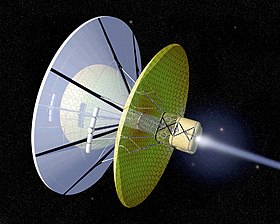The Bussard ramjet is a theoretical method of spacecraft propulsion for interstellar travel. A fast moving spacecraft scoops up hydrogen from the interstellar medium using an enormous funnel-shaped magnetic field (ranging from kilometers to many thousands of kilometers in diameter); the hydrogen is compressed until thermonuclear fusion occurs, which provides thrust to counter the drag created by the funnel and energy to power the magnetic field. The Bussard ramjet can thus be seen as a ramjet variant of a fusion rocket.[citation needed]


The Bussard ramjet was proposed in 1960 by the physicist Robert W. Bussard.[1]
The concept was popularized by Poul Anderson in his novel Tau Zero, Larry Niven in his Known Space series of books, Vernor Vinge in his Zones of Thought series, and Carl Sagan, as referenced in the television series and book Cosmos.[citation needed]
Since the time of Bussard's original proposal, it has been discovered that the region surrounding the Solar System has a much lower density of hydrogen than was believed at that time (see Local Interstellar Cloud). In 1969, John Ford Fishback made an important contribution, describing the details of the required magnetic field.[2]
In 1978, T. A. Heppenheimer analyzed Bussard's original suggestion of fusing protons, but found the Bremsstrahlung losses from compressing protons to fusion densities was greater than the power that could be produced by a factor of about 1 billion, thus indicating that the proposed version of the Bussard ramjet was infeasible.[3] However, Daniel P. Whitmire's 1975 analysis[4] indicates that a ramjet may achieve net power via the CNO cycle, which produces fusion at a much higher rate (~1016 times higher) than the proton–proton chain.[citation needed]
Robert Zubrin and Dana Andrews analyzed one hypothetical version of the Bussard ramjet design in 1988.[5] They determined that their version of the ramjet would be unable to accelerate into the solar wind.[citation needed]
A 2021 study found that, while feasible in principle, the practical construction of a useful Bussard ramjet would be beyond even a civilization of Kardashev type II.[6][7]
The problem of using the interstellar medium as the sole fuel source led to study of the Ram Augmented Interstellar Rocket (RAIR). The RAIR carries its nuclear fuel supply and exhausts the reaction products to produce some of its thrust. However it greatly enhances its performance by scooping the interstellar medium and using this as extra reaction mass to augment the rocket. The propulsion system of the RAIR consists of three subsystems: a fusion reactor, a scoop field, and a plasma accelerator. Fuel is launched ahead of the ship with the accelerator.[8] The scoop field funnels the fuel into another accelerator (this could for example be a heat exchange system transferring thermal energy from the reactor directly to the interstellar gas) which is supplied power from a reactor. One of the best ways to understand this concept is to consider that the hydrogen nuclear fuel carried on board acts as a fuel (energy source) whereas the interstellar gas collected by the scoop and then exhausted at great speed from the back acts as a propellant (the reaction mass), the vehicle therefore has a limited fuel supply but an unlimited propellant supply. A normal Bussard ramjet would have an infinite supply of both. However, theory suggests that where a Bussard ramjet would suffer drag from having to pre-accelerate interstellar gas to its own speed before intake, a RAIR system would be able to transfer energy via the "accelerator" mechanism to the interstellar medium despite velocity differences, and so would suffer far less drag.[9][10][11][12]
Beamed energy coupled with a vehicle scooping hydrogen from the interstellar medium is another variant. A laser array in the solar system beams to a collector on a vehicle which uses something like a linear accelerator to produce thrust. This solves the fusion reactor problem for the ramjet. There are limitations because of the attenuation of beamed energy with distance.[13]
The calculations (byRobert Zubrin and Dana Andrews) inspired the idea of a magnetic parachute or sail. This could be important for interstellar travel because it means that deceleration at the destination can be performed with a magnetic parachute rather than a rocket.[14]
Astrophysicist Matthew E. Caplan of Illinois State University has proposed a type of stellar engine that uses a Dyson swarm of mirrors to concentrate stellar energy onto certain regions of a Sun-like star, producing beams of solar wind to be collected by a multi-ramjet assembly which in turn produces directed jets of plasma to stabilize its orbit and oxygen-14 to push the star. Using rudimentary calculations that assume maximum efficiency, Caplan estimates the Bussard engine would use 1015 grams per second of solar material to produce a maximum acceleration of 10−9 m/s2, yielding a velocity of 200 km/s after 5 million years, and a distance of 10 parsecs over 1 million years. The Bussard engine would theoretically work for 100 million years given the mass loss rate of the Sun, but Caplan deems 10 million years to be sufficient for a stellar collision avoidance.[15]
Several of the obvious technical difficulties with the Bussard ramjet can be overcome by setting out solid pellets of fuel along the spacecraft's trajectory in advance.[16] This could be done using a different "tanker" spacecraft dropping fuel pellets[16][17] or using laser propulsion.[18] The method has been referred to as the "fusion runway",[16][18] ramjet runway[17] or "forward resupply runway".[19]
While most proposals use fusion power, as with conventional Bussard ramjets, fission has also been suggested.[19]
The advantages of this system include:
The major disadvantages of this system include:[citation needed]